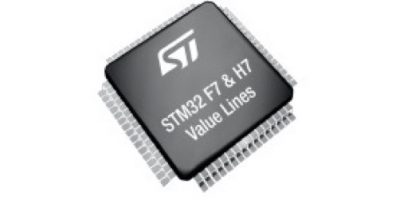Microcontrollers have flexibility to create performance-specific IoT devices
Additions to the STM32 microcontroller family by STMicroelectronics are designed to provide design flexibility to create performance-oriented systems that are affordable and secure.
The STM32F7x0 and H7x0 Value Line microcontrollers can be used. For example, in real-time IoT devices, without compromising features or cyber protection, says STMicro.
The microcontrollers trim embedded flash, while still allowing secure boot, sensitive code and real-time routines to run safely on-chip, leveraging access times over 25 times faster than for external flash (for cache miss). Applications can scale-up as required, either by adding off-chip serial or parallel (up to 32-bit) memories and leveraging the microcontrollers’ external interfaces and eXecute in Place (XiP) capability, or by porting to other pin-to-pin compatible microcontrollers from STMicro, namely the STM32F7 or STM32H7 MCU lines, with up to 2Mbyte flash and up to 1Mbyte RAM, supported by the same ecosystem and tools.
The Value Lines retain the STM32F7 and H7 features, such as peripherals, hardware accelerators, and the real-time architecture with fast internal buses, short interrupt latency, and fast boot-up, of around one millisecond. The microcontrollers are energy efficient, with flexible power modes, gated power domains, and on-chip power management that simplify design and reduce bill of materials cost.
At the heart of the secure, power-efficient architecture is execution performance of up to 2020 CoreMark, making the Value Line devices a suitable entry point to IoT design in medical, industrial, and consumer applications. With up to 125 degree C as the maximum junction temperature, developers can leverage the full core and peripherals performance even when ambient temperature increases.
The entry-level STM32F730 delivers 1082 CoreMark performance running at 216MHz aided by ST’s ART Accelerator for zero-wait-state execution from flash. Features include cryptographic hardware acceleration, a USB 2.0 high speed port with PHY, and a CAN interface. There is a 64kbyte flash, eight-kbyte instruction and data caches for high-performance execution from internal or external memories, 256kbyte of system RAM and 16kbyte+64kbyte of tightly coupled memory (TCM) for the most critical routines and data.
The STM32F750 adds a TFT-LCD controller with ST’s proprietary Chrom-ART graphics accelerator. It has hardware acceleration for hash algorithms, two CAN interfaces, an Ethernet MAC, camera interface, and two USB 2.0 interfaces with full speed PHY. There are 64kbytes of flash, four-kbyte instruction and four-kbyte data caches, 320kbyte of system RAM, and 16kbyte+64kbyte TCM.
The STM32H750 delivers 2020 CoreMark performance at 400MHz and adds a hardware JPEG coder/decoder to the TFT controller and Chrom-ART Accelerator for even faster graphic user interface (GUI) performance boasts ST. There is also a CAN-FD port and additional CAN-FD with time-trigger capability and what are claimed to be best-in-class operational amplifiers and 16-bit ADCs running at up to 3.6Msample per second. The 128kbyte flash, 16kbyte instruction and data caches, 864kbyte system RAM and the 64kbyte+128kbyte of TCM all feature error correction code (ECC) for safe execution from internal or external memory.
The STM32F730, STM32F750, and STM32H750 Value Line microcontrollers are in production, in LQFP and BGA package options from 64-pin to 240-pin.




